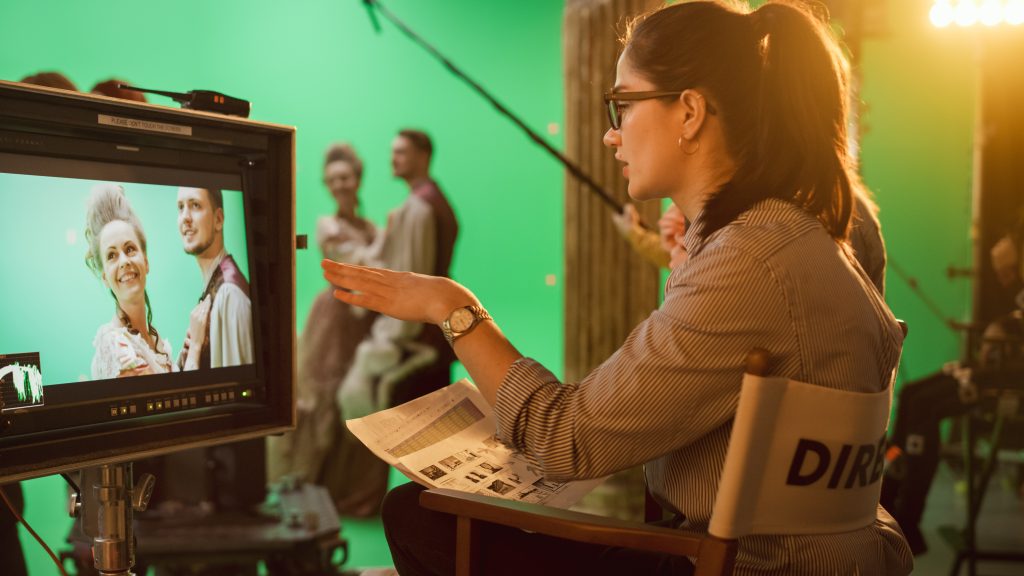Many decide to major in art and design because of a personal passion, but art can provide a career that is as lucrative as it is meaningful. One such career is the role of creative director. Top earnings and a favorable job outlook are promised in certain creative director roles. Specifically, creative directors in the field of advertising are among the highest-paid professionals in the field of art and design. Experienced creative directors earn above-average wages and enjoy the freedom that comes with being a creator. To become a creative director, you must first earn a college degree.
The education required for aspiring creative and art directors is detailed below. You will also find current information on the earnings potential and job outlook for this occupation.
Education for Aspiring Creative Directors
Creative directors are idea people. They lead teams of talented creatives in developing and carrying out ideas in various art industries, such as advertising, film, graphic design, and music. It is essential that creative directors thoroughly understand the industry in which they work and are able to perform tasks like managing a team, making decisions, solving problems, and providing criticism constructively. They must also handle the less creative tasks, like dealing with budgets and schedules that are necessary for implementing ideas. The first step to gaining these skills and abilities is completing college coursework.
A good place for aspiring creative directors to begin their career preparation is to study in the field in which they intend to work. Because a creative director role is not an entry-level job, college students should plan to start working within the industry upon graduation and eventually work their way up to the role of creative director. Before heading to work, a college degree must be earned.
Art or creative directors must hold a minimum of a bachelor’s degree in art, design, or a related discipline. While some creative directors earn their degree in fine arts, others hold bachelor’s degrees in communications technology, advertising, or marketing. The point is that there is no single degree path to becoming a creative director. However, earning a bachelor’s degree is an important part of meeting the qualifications for the job. Students gain the appropriate education before pursuing a creative role, and they can pursue advancement after experience is gained on the job.
Some students opt for a master’s degree after earning the bachelor’s degree or BFA. In fact, some employers see a master’s degree as equal to two years of work experience in an advanced creative role. Creative directors may hold an MFA or master of fine arts degree in an area of interest. The MFA degree supplements work experience and showcases a student’s creative or managerial ability.
Work Experience for Creative Directors
No matter how talented and passionate you are, you likely won’t begin a career straight out of college as a creative director. The role must be worked up to after completing relevant work experience. Some employers expect five years or more of work experience before you can qualify for a role as a creative director. You will need to prove yourself in the industry, whether you are working as a copywriter, graphic designer, or member of a creative team in film or music development.
During the time spent as a member of a creative team, you will develop some of the skills touched on in the classroom. These skills will include the ability to focus on both the big picture of an emerging idea and the individual steps needed to bring an idea to fruition. In your interactions with a creative team, you will develop your teamwork, leadership, and decision-making skills by taking on new responsibilities and championing your work.
Most creative directors have at least five years of work experience in another occupation before they assume the leadership role. Once you step into the creative director position, you will find a fulfilling and financially rewarding career, but your entire career path should be considered before embarking on your educational path. Since you will likely take an entry-level job in an area of art or design, you should choose a role that best aligns with your creativity and talent. Don’t choose to seek a creative director career in graphic design, for example, if you’re not willing to spend the time working your way up in the field of graphic design. Because of the wide variety of career options for creative directors, students can choose a major and industry that they are truly passionate about.
Other Important Qualities for Creative Directors
In addition to the proper education and work experience, successful creative directors possess certain important qualities and characteristics. While some of these skills may be developed in the classroom or on the job, some are considered soft skills. Soft skills are interpersonal, non-technical skills that relate to how you, as a person, work. These skills may include how you solve problems, manage work, or interact with colleagues. Below are several skills and qualities that are important to your success as a creative director.
Communication skills: In any director role, communication skills are necessary. Creative directors must be able to listen to and speak with colleagues, staff, and clients to ensure ideas are heard and addressed. Whether in advertising or on movie sets, communication skills are an important part of the job as a creative director.
Creativity: Coming up with new, innovative, and creative ideas is part of the job as a creative director. In advertising, creative directors must develop ad campaigns and unique branding ideas. They must develop set designs or creative layout options for clients. In this role, creativity is a major requirement for the job.
Leadership skills: Creative directors manage and motivate other artists and creators. They must articulate their vision clearly and oversee projects. They must also ensure the work gets done on time and oversee the quality of work as it progresses. Having strong leadership skills helps one succeed in this unique role.
Resourcefulness: Often, creative directors are called on to adapt their latest designs to the changing technology used in their industry. In advertising and marketing, creative designs are adapted for social media and online platforms. Being resourceful, and thinking outside of normal boundaries, helps one succeed in the role of creative director.
Time-management skills: Creative directors are constantly meeting deadlines, often tight ones, while juggling multiple projects. In order to meet strict deadlines, one must be able to balance priorities with strong time-management skills.
Earnings Potential for Creative Directors
The Bureau of Labor Statistics (BLS) reports that the median annual wage for art and creative directors was $97,270. The median wage is the wage that half of the workers in this occupation earned more than and half earned less than. According to BLS, the highest 10% of earners made over $199,250 in annual wages, while the lowest 10% made less than $54,530.
Wages for this occupation vary by industry and geographic location. In fact, BLS shares four top-paying industries for creative directors. Two of the four industries offer higher-than-average wages for this occupation. The highest-paying industry for art and creative directors is film. Motion-picture and video industries offer median annual wages of $122,960. That’s more than $25,000 higher than the average wage for this occupation. Other top-paying industries include advertising, public relations, and related services; specialized design services; and newspaper, periodical, book, and directory publishers. While the highest-paying industry for creative directors is motion picture and video, the second-highest-paying industry is advertising, PR, and related services. Art or creative directors working in advertising earn an average annual wage of $99,890.
Not only do wages vary by industry, they also vary by geographic location. A creative director working in a metropolitan area might earn higher wages than one working in a rural location. According to BLS, five states in the U.S. pay high wages for art and creative directors. These states are New York, California, New Jersey, Oregon, and Washington. All these states offer higher-than-average wages for this occupation. In New York — the highest-paying state for art directors — earnings average $142,210. California offers the second-highest earnings for creative and art directors with a median annual wage of $140,740. The third-highest-paying state is New Jersey, where creative and art directors earn an average annual salary of $121,940. Art directors in Oregon see an average annual wage of $115,070, and they see an average wage of $113,610 in Washington.
Metropolitan areas also offer higher-than-average wages for creative directors. According to BLS, the highest-paying metro areas for this occupation include Los Angeles, Long Beach, and Anaheim, California, where art and creative directors earn an annual mean wage of $147,020. Other top-paying metro areas where art directors can expect an annual mean wage of above $140,000 include San Francisco, Oakland, and Hayward in California and New York, Newark, and Jersey City in New York, New Jersey, and Pennsylvania.
Job Outlook for Creative Directors
BLS reports a favorable job outlook for creative directors, as demand for this occupation rises each year. Employment of art and creative directors is projected by BLS to grow 11% through 2030. This growth is three percent faster than the eight-percent average for all other occupations and seven percent faster than the growth of four percent for all art and design occupations.
With print publications shifting their focus to other media forms in a desperate attempt to stay relevant and gain ground, art and creative directors are following suit, shifting attention to design work on websites and mobile platforms. This shift in focus is expected to spark a growing demand for this occupation. In fact, about 11,500 job openings for art and creative directors are projected over the next decade.
In addition to the industry’s shift in focus, growth should result from the need to replace workers who exit the labor force through retirement or job transfer. Job openings will be filled by those with knowledge in contemporary media platforms. Since there is competition for creative director roles, those with education and experience in mobile platforms, applications, and website design should see the best job prospects.
It is also projected that nearly 60% of art and creative director jobs will be held by self-employed workers over the next decade. 12% of art and creative directors will work in advertising, public relations, and related services and three percent will work in motion picture and video industries. Another three percent will be involved in newspaper, periodical, book, and directory publishing and three percent will work in specialized design services.
Other Jobs to Consider as a Creative Director
There are several different jobs you might consider if you’re having trouble landing a creative director role. Since the number of creative director jobs is limited, consider working as an editor, fine artist, graphic designer, or photographer. Of course, your interests should align with your career choice and industry. Optional career paths are detailed below.
Editor: Editors usually hold a degree in communications, English, or journalism. They edit, plan, review, and revise content for publication, whether online or related to physical publication.
Fine artist: Fine artists are skilled in using certain materials and techniques to create art for sale and exhibition. Types of artists may include cartoonists, painters, and sculptors, as well as those that incorporate different media, like glass artists, printmakers, or sketch artists. Fine artists may also be graphic or digital artists who use design and production software to create interactive art online.
Photographer: Skilled in photography, this specially trained artist uses technical expertise and creativity to produce and preserve images. Different types of photographers include commercial and industrial photographers, fine arts photographers, news photographers, portrait photographers, and scientific photographers. Most photographers are self-employed, though some work for businesses and organizations.
Related Resources:
- 5 Career Options with a Bachelor’s in Graphic Design
- 20 Best Online Bachelor’s in Graphic Design Programs
- Best University Jazz Programs
- Online Bachelor’s in Anthropology Degree: 30 Best
- Ultimate Guide to Arts Degrees and Careers
- What Is the Best Degree Path for Becoming a Graphic Designer?




